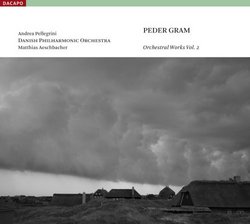| All Artists: P. Gram, Danish Philharmonic Orchestra, Andrea Pellegrini, Matthias Aeschbacher Title: Peder Gram: Orchestral Works Vol .2 Members Wishing: 0 Total Copies: 0 Label: Da Capo [Naxos] Original Release Date: 1/1/2008 Re-Release Date: 3/25/2008 Genres: Pop, Classical Styles: Vocal Pop, Symphonies Number of Discs: 1 SwapaCD Credits: 1 UPC: 747313691821 |
Search - P. Gram, Danish Philharmonic Orchestra, Andrea Pellegrini :: Peder Gram: Orchestral Works Vol .2
 | P. Gram, Danish Philharmonic Orchestra, Andrea Pellegrini Peder Gram: Orchestral Works Vol .2 Genres: Pop, Classical |
Larger Image |
CD Details |
CD ReviewsThree Beautiful Romantic Works from a Danish Composer J Scott Morrison | Middlebury VT, USA | 05/16/2008 (5 out of 5 stars) "We are truly in an age of recorded treasures. Although Peder Gram (1881-1956) is all but forgotten now -- I had never heard of him -- the Danish record company, da capo, has resurrected several of his symphonic works in this and an earlier volume. I have not heard the earlier recording, but the music on the present CD is simply lovely. Gram writes in a completely tonal style, has utter control of his music's formal elements, writes immediately appealing melodies, and is a virtuosic orchestrator. The performances of the Danish Philharmonic Orchestra under Matthias Aeschbacher are all one could ask for.
The CD opens with a song for mezzo-soprano and orchestra, 'Avalon', written in 1917. It sets a poem by Gram's former schoolmate and popular Danish poet, Erik Stokkebye, that retells the legend of Avalon, that fabled Celtic isle in which 'heroes live on after death, surrounded by beautiful fairies.' It is a lushly orchestrated work whose harmonies are reminiscent of French impressionism and whose feeling of otherworldliness is underscored by wavering figures in the harp, horns and solo oboe. The fine singer in this and the Second Symphony's third movement is Andrea Pellegrini. The Second Symphony (1925), lasting 28 minutes, is in five movements that are played almost without pause; Gram insisted that it was actually a single movement with five sections. 'Entrata' opens with a chromatic three-note figure interrupted by brass chords. Those three notes provide material for almost the entire symphony. The second section, 'Recitativo', features an oboe recitative interspersed with a meditative, even exalted, chorale-like texture. 'Melodia' features a mezzo soloist singing verses, again by Erik Stokkebye, extolling the beauties of Spring in forest and field. 'Azione' ('Action'), by far the longest section (lasting almost twelve minutes), is a densely contrapuntal action-piece whose weighty brass is counterbalanced by perky woodwind figures and bustling strings. This ends with a cymbal crash followed immediately by 'Epilogo', a multisection summation of what has gone before with much use of the three-note opening figure. It ends with a serene restatement of the opening music from the symphony's beginning. A masterful work deserving of attention. There is a charming story about the origin of the Third Symphony (1954). For many years Gram had been the head of the Music Department of Danish Radio. At his retirement from that post in 1951 he was presented with a finely bound score book with the inscription: 'Peder Gram - Symphony No. 3'. Inside, the pages were blank, a not so subtle hint that after almost twenty-five years it was time for Gram to add to his earlier two symphonies. Four years later the symphony was premiered with Gram conducting. The work's three movements last half an hour and are, roughly, slow-slow-fast. But, truth to tell, all three movements are relatively slow in the main. Gram's harmonic language, while still tonal, is a bit more astringent than that of 'Avalon' or the Second Symphony, and there is more than a little that sounds hieratic. It is of note that by this time Gram had been influenced by his elder colleague, Carl Nielsen, particularly in his use of harmony and melodic construction. This is not to say that the work is epigonic; Gram is his own man. The first movement is maestoso, the second lyrical, the third march-like. There is what feels like an inevitability to the work's form, with a logical although not necessarily predictable progression to the third movement's celebratory manner. These works serve notice that Peder Gram's obscurity should end. He is a masterful composer of finely crafted works that deserve to see the light of day once more. Thanks are due to da capo for bringing them to our attention. Scott Morrison " |
